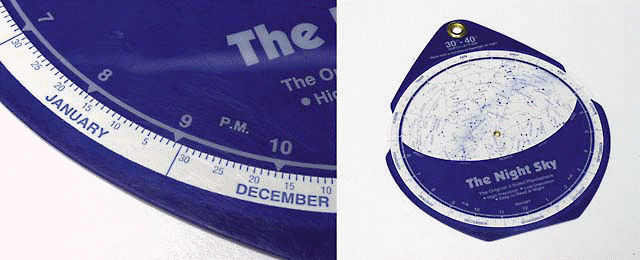Know Your Constellations!
Do you know your constellations?
If it's one thing I've repeatedly discovered on a clear night out with others is that most people don't know their constellations. Which is a shame since knowing your constellations is such a basic and easy skill that connects you with people all over the earth just as much as knowing how to find the moon.
I love knowing the constellations. It makes the sky a familiar place.
One of the easiest ways to first learn your constellations is to get a planisphere. A planisphere is basically a flat map of the sky drawn on a flat piece of paper, plastic or cardboard. It includes a rotatable mask that only exposes the part of the sky visible at your location, time and date. Each planisphere can only be used for certain latitudes on earth.
The image below shows an example planisphere. You simply line up the date with the time and it shows you the sky at your location (image credit: Sky and Telescope):

Notice from the image that the sky will look the same on December 17th at 10pm as it does on January 16th at 8pm! That's because for every day that passes, the stars rise about 4 minutes earlier. This adds up to about 2 hours over the course of a month. This apparent shift of the stars day to day is simply the result of the earth traveling around the sun.
Click on the image above to read an excellent article on Sky and Telescope's site for more on how to use a planisphere.
You can purchase planispheres online at several sites:
- David H. Levy's Guide to the Stars Planisphere - $19.95
- Night Sky Miniplanisphere - $5.95 - good for a small one
- Precision Planet and Star Locator - $20.95 - the "mercedes" of planispheres
- Orion Star Target Planisphere - $9.95
As you can see, planispheres come in different sizes, styles and prices (make sure it is correct for your latitude).
If you don't want to spend money on becoming familiar with the stars, you can download a planisphere template from discovery.com: Planisphere template. You just print out the pages, cut and put them together! Make it a project with any young ones in the house!
Learning the sky can ALSO be done by going to skymaps.com. Here you can get FREE PDF printouts of what the sky should look like every month, and for BOTH hemispheres!
So how did I learn the sky? I learned some from websites like these, but mostly from having 2 star map posters, one at home and one at the office. I also learned from Jay Pasachoff's book: A Field Guide to the Stars and Planets which includes 52 atlas charts of the sky.
So get out there and learn the constellations today!








0 Comments:
Post a Comment
<< Home